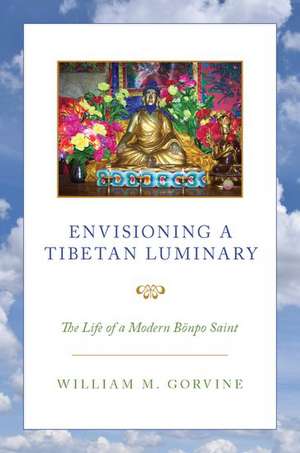Envisioning a Tibetan Luminary: The Life of a Modern Bönpo Saint
Autor William M. Gorvineen Limba Engleză Paperback – 3 ian 2019
| Toate formatele și edițiile | Preț | Express |
|---|---|---|
| Paperback (1) | 250.72 lei 10-16 zile | |
| Oxford University Press – 3 ian 2019 | 250.72 lei 10-16 zile | |
| Hardback (1) | 588.78 lei 31-37 zile | |
| Oxford University Press – 10 ian 2019 | 588.78 lei 31-37 zile |
Preț: 250.72 lei
Nou
Puncte Express: 376
Preț estimativ în valută:
47.98€ • 50.22$ • 39.93£
47.98€ • 50.22$ • 39.93£
Carte disponibilă
Livrare economică 27 februarie-05 martie
Preluare comenzi: 021 569.72.76
Specificații
ISBN-13: 9780199362356
ISBN-10: 0199362351
Pagini: 328
Dimensiuni: 231 x 155 x 20 mm
Greutate: 0.45 kg
Editura: Oxford University Press
Colecția OUP USA
Locul publicării:New York, United States
ISBN-10: 0199362351
Pagini: 328
Dimensiuni: 231 x 155 x 20 mm
Greutate: 0.45 kg
Editura: Oxford University Press
Colecția OUP USA
Locul publicării:New York, United States
Recenzii
Envisioning a Tibetan Luminary is a much-needed contribution to the study of Himalayan religions, and scholars of Buddhism would be wise to reflect on its contents as a model for investigating the relationship between Buddhism and its local and regional folk practices.
the book would be ideal for an undergraduate course on methodology or a course focused around coaching students in developing their skills of textual analysis.
[H]ighly illuminating to specialists wanting to learn more about the recent history of Bön, those interested in the study of hagiographic production, or anyone who appreciates carefully conducted and exquisitely written scholarship.
William Gorvine's Envisioning a Tibetan Luminary brings to life the figure of Shardza Tashi Gyaltsen, one of the most influential (and controversial) Bönpo scholars of all time. Much more than a biography, Gorvine's work is also an analysis of Shardza's writings and historical context. It is also, by the way, a wonderful introduction to Bön, Tibet's 'indigenous' religion. Erudite yet accessible, this book is a must read for anyone interested in Tibetan religion.
Envisioning a Tibetan Luminary is our most expansive exploration to date of traditional Tibetan approaches to Bön life writing. Gorvine illuminates for the first time the ways in which Bönpo authors sought to represent new forms of religiosity, self-identity, and institutional legitimacy in an overwhelmingly Buddhist landscape. This work does much to expand and complicate our understanding of religion in Tibet and the Himalayan region.
Gorvine's narrative is a brilliant exposition of the general tenets of the Tibetan Bön religion. This represents an excellent introduction to the doctrine and ascetic practices of Bön as demonstrated through the life of one of its most beloved and celebrated recent masters. The rationale of this study is to highlight the function of a Tibetan literary genre, the hagiography (namtar), as a teaching device as well as to inspire practitioners and the faithful. Gorvine not only manages to convey the full extent of the original two Tibetan works but is also able to contextualize the events reported as well as the nature and type of spiritual work Shardza was engaged in. In this way, students of Bon as well as scholars researching the material that is the basis for practice amply demonstrated here are able to benefit from the reading of this very accessible study.
the book would be ideal for an undergraduate course on methodology or a course focused around coaching students in developing their skills of textual analysis.
[H]ighly illuminating to specialists wanting to learn more about the recent history of Bön, those interested in the study of hagiographic production, or anyone who appreciates carefully conducted and exquisitely written scholarship.
William Gorvine's Envisioning a Tibetan Luminary brings to life the figure of Shardza Tashi Gyaltsen, one of the most influential (and controversial) Bönpo scholars of all time. Much more than a biography, Gorvine's work is also an analysis of Shardza's writings and historical context. It is also, by the way, a wonderful introduction to Bön, Tibet's 'indigenous' religion. Erudite yet accessible, this book is a must read for anyone interested in Tibetan religion.
Envisioning a Tibetan Luminary is our most expansive exploration to date of traditional Tibetan approaches to Bön life writing. Gorvine illuminates for the first time the ways in which Bönpo authors sought to represent new forms of religiosity, self-identity, and institutional legitimacy in an overwhelmingly Buddhist landscape. This work does much to expand and complicate our understanding of religion in Tibet and the Himalayan region.
Gorvine's narrative is a brilliant exposition of the general tenets of the Tibetan Bön religion. This represents an excellent introduction to the doctrine and ascetic practices of Bön as demonstrated through the life of one of its most beloved and celebrated recent masters. The rationale of this study is to highlight the function of a Tibetan literary genre, the hagiography (namtar), as a teaching device as well as to inspire practitioners and the faithful. Gorvine not only manages to convey the full extent of the original two Tibetan works but is also able to contextualize the events reported as well as the nature and type of spiritual work Shardza was engaged in. In this way, students of Bon as well as scholars researching the material that is the basis for practice amply demonstrated here are able to benefit from the reading of this very accessible study.
Notă biografică
William M. Gorvine is Associate Professor of Religious Studies at Hendrix College. His research explores religious biography, conceptions of saintliness, and the Tibetan Bön religion, while his teaching and professional work support interdisciplinary approaches to Asian studies, contemplative pedagogy, andreligious literacy.
